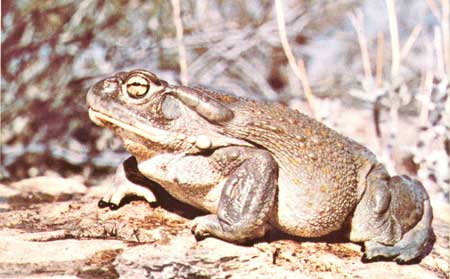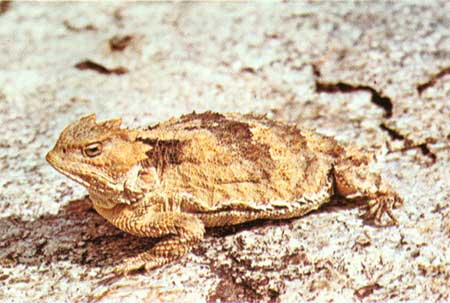|
SAGUARO National Park |
 |
animals and how they survive
Just as plants depend for their existence on soil, water, and sunlight, so animals, including man, depend on plants. For green plants are the basic food producers in nature, manufacturing carbohydrates, proteins, and other essential compounds from minerals, air, and water, with the help of chlorophyll and the sun's energy. Animals get their food either by eating green plants or by eating animals that have eaten plants. Microscopic decomposers complete this food chain, breaking down dead plants and animals into substances that once again can be used by plants. Since each link in the chain depends on the other links, it's not hard to see that a change in one will cause a change in the others. And because animals depend on plants for cover as well as for food, their fortunes are doubly tied to the welfare of plants.
Animals and plants share some of the same basic problems—particularly, how to stay within tolerable temperature limits, and how to maintain an adequate supply of water. Plants solve these problems mostly by structural adaptations, animals mostly by behavioral. In the desert, for instance, cold-blooded animals such as snakes and lizards (which have no internal control over body temperature) crawl underground or into shade during the midday heat of summer, and come out to hunt food during the cooler hours. Birds and mammals cool themselves through evaporation of water from their bodies. This makes water conservation doubly critical for them; they too handle it by staying in the shade or going underground during hot times. Desert animals get much of their water from the plants and animals they eat, but some species, such as mule deer and Gambel's quail, require large amounts of drinking water as well.
 Jerusalem cricket (of a different family from the true crickets) has legs adapted for tunneling in sand. |
Cold weather poses another problem. Most reptiles and some mammals solve this one by hibernating underground or in rock dens, where temperatures remain moderate throughout the year. Many birds and some mammals migrate to areas where temperatures are warmer and food is more abundant, which may mean going farther south or simply moving down the mountainsides. And insects can survive in a dormant form, as eggs or pupae, though many species remain active during the temperate Sonoran winters.
If you want to see animals, then, go where the vegetation is thickest and most varied, and go when temperatures are moderate. During warm seasons in the desert, this means that walking the washes early or late in the day will give you the best chances for seeing wildlife. Coveys of Gambel's quail explode into the air, peccaries snort through the underbrush, butterflies festoon flowering shrubs, and coyotes stealthily hunt.
Invertebrates
Insects are generally not bothered by excessive heat, and many species are active during the hottest hours. This is especially true when the plant blossoming season is at its height. Flowers of the mesquite, paloverde, catclaw, saguaro, and other desert plants are "alive" all through the day, as many species of insects seek nectar and pollen or prey on other insects attracted to the blossoms. Insects are fed upon by various species of birds; flycatchers flock to parts of the desert where nectar-yielding flowers are numerous. Because of the absence of extreme cold, the desert climate enables insects to be active throughout much of the year and to support a considerable bird population.
Insects play a far more important role in the plant and animal life of the desert than is usually realized. Many desert flowers must be insect pollinated to produce viable seeds. Birds of many kinds depend upon insects for food, and even the seed-eating birds, during the nesting season, rely upon insects to provide the enormous quantities of food and moisture required by their fast-growing nestlings. Many other desert creatures, including certain snakes and lizards and some spiders, depend upon insects for food. The body juices of the insects provide the all-important moisture—which these creatures can get from no other source. Bats, too, are insect eaters, spending the hours of darkness in seemingly aimless and erratic flight while foraging for moths and other night-flying insects that visit the light-colored blossoms of night-blooming plants.
 Despite its fearsome appearance and reputation, you have nothing to fear from the tarantula. (Photo by Harold T. Coss, Jr.) |
Some species of insects may become so numerous that they threaten the very life of the plants on which they live. Pine bark beetles annually damage or kill numbers of pinyons and ponderosas in the Rincon Mountains, but have been kept sufficiently under control by their natural enemies so that their ravages have not reached epidemic proportions.
Among the common spectacular insects is the TARANTULA HAWK, a large blue-black, red-winged wasp that preys on large spiders. Temporarily paralyzing the spider with its sting, the wasp lays a single egg on its victim, thereby assuring an abundance of living food for its young. The PRAYING MANTIS is another large insect, usually green and inconspicuous among the foliage of desert plants, which it frequents in search of small insects. Ants of many species are active almost everywhere in the desert, harvesting seeds of various plants. Some species construct mazes of underground nest tunnels and deposit the excavated materials on the surface, forming conical, sometimes, craterlike, anthills.
 The small desert hairy scorpion is the only scorpion in the monument that is dangerous to humans. (Photo by Harold T. Coss, Jr.) |
Along with the insects, other arthropods (jointed-leg creatures with exoskeletons) find their home in the desert. The arachnids (eight-legged arthropods) include spiders and scorpions. Of the former, the NORTH AMERICAN TARANTULAS are famous for their large size and formidable appearance, which have given them the wholly undeserved reputation of being dangerous to humans. The really dangerous creatures are the SCORPIONS, whose long, flexible tails bear a poisonous stinger at the tip. Several species are found in the monument; but only the small, straw-colored scorpion has venom known to have been fatal to humans. The other scorpions found in the area can inflict painful stings, but with only localized and rarely serious effects.
Amphibians
As might be expected, amphibians are scarce in the monument because of lack of permanent water. The few springs and seeps, however, furnish excellent breeding places for several species of amphibians. Best known among these are the RED-SPOTTED TOAD, LEOPARD FROG, and CANYON TREEFROG, the latter common near Manning Camp. A spectacular desert amphibian and the second largest toad in the United States, is the huge COLORADO RIVER TOAD, sometimes found near residences in the evening when outdoor lights attract swarms of insects.
 The Colorado River toad is exceeded in size among U.S. toads only by the giant toad of south Texas (and Mexico). (Photo by Harold T. Coss, Jr.) |
Reptiles
Except for small lizards, reptiles are not much in evidence in the monument. Nevertheless, they are present and are important in the various plant-and-animal communities in which they live. Almost all lizards are insectivorous, and along with birds and other insect-eaters help to keep the number of insects within bounds. A notable exception is the GILA (HEE-lah) MONSTER. (See appendix for scientific names of reptiles) largest of the lizards found in the United States. (It is one of the world's two poisonous lizards, and the only one found in this country.) The gila monster is especially fond of bird eggs, and also eats nestlings and small rodents, obtaining necessary moisture from their body juices. These food habits are quite similar to those of the several species of snakes found in the monument, the majority of which are perfectly harmless to humans.
 The short-horned more cold-tolerant than the desert horned lizard, ranges from the foothills into the mountain forests of Saguaro. (Photo by Harold T. Coss, Jr.) |
Just as the lizards help to control the insect population, the snakes are important in preventing the buildup of large numbers of rodents that would result in widespread damage to vegetation. Visitors to the monument rarely have the opportunity to observe snakes, since they are in hibernation during winter and remain in the shade or in underground burrows during the hot part of each summer day. Perhaps those most frequently seen are the GOPHER SNAKE and the COACHWHIP. Many desert snakes hunt only at night; others that are normally active during days of moderate temperatures become night hunters during hot weather. Although they are not abundant, there are several kinds of rattlesnakes in the monument, the commonest desert species being the WESTERN DIAMONDBACK and MOHAVE RATTLESNAKES. Except for the small, very rare, and secretive ARIZONA CORAL SNAKE, rattlesnakes are the only poisonous snakes in the monument. Snakes, like other living things in the national monument, are protected by law.
 The Mojave rattlesnake prefers desert, grassland, and open brushland to densely vegetated areas. (Photo by Harold T. Coss, Jr.) |
Don't be surprised while following a desert footpath to come upon a plodding tortoise. This bona fide desert dweller, the DESERT TORTOISE, is a vegetarian, feeding on cactus, grass, and other low-growing plants.

|

|
|
|
|
Last Modified: Sat, Nov 4 2006 10:00:00 pm PST |


